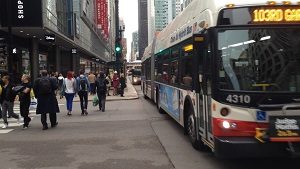When we use public transportation, we entrust the public transit operator with our health and well-being. Many people opt for public transportation as a cost-efficient, fast, and convenient way to get to their destination. While buses, subways, trolleys, and trains offer a relatively safe mode of transportation, accidents may still happen.
If you or someone you love suffered injuries in a public transportation accident, consider speaking with one of our lawyers to explore your legal options and fight for the compensation you deserve. Abels & Annes, PC, takes on tough cases against public transportation companies and other parties, and we can advise you of your options.
Common Types of Public Transportation Accidents
Chicago has many options for getting around town, and everyone who comes to the city can find something that works for them as a result. Most of these commuters and travelers will avoid major issues, but for some, a car accident, train crash, or even a bus collision may leave them wondering about their legal options.
Public transportation accidents are also called public transit or mass transit accidents. There are different types of mass transit accidents depending on the form of the public transportation involved.
Typically, there are four types of public transportation accidents in Chicago:
- Subway accidents. Accidents on a subway may occur as a result of a derailment, sudden stops, inadequate maintenance, or mechanical malfunction. However, passengers may also sustain injuries in slip and fall accidents on the subway platform or as a result of assaults or being caught in the doors of a subway car. In extreme cases, a passenger may fall onto subway tracks from slipping, tripping, or being pushed by other passengers.
- Bus accidents. Bus accidents are not an uncommon occurrence on Chicago roads. Bus drivers are not at fault for all accidents, as they may crash due to another driver’s negligence or recklessness. Bus passengers may sustain injuries when the bus collides with other vehicles on the road, or they fall while riding the bus due to an abrupt stop or turn. In some cases, passengers may suffer injuries when the bus begins moving while the passenger is still exiting or entering the bus. Unlike other vehicles on the road, buses do not have safety belts and airbags, which means bus passengers are more likely to suffer severe injuries when a collision occurs.
- Train accidents. While train accidents are not as common as bus accidents, they can result in catastrophic and debilitating injuries. Train accidents may occur because of derailment, mechanical failure, operator error, defective tracks, or unprotected railroad crossings. Trains may also collide with motor vehicles at railway crossings. Passengers may also suffer injuries from slipping and falling on the train station or assaults from other passengers.
- Taxi accidents. Unfortunately, many taxi drivers violate traffic rules to increase their profits. However, failure to follow traffic laws often results in preventable road accidents involving other drivers, bicyclists, motorcyclists, and pedestrians. Taxi passengers may also suffer serious injuries when collisions occur. Often, recovering damages after a taxi accident is a rather straightforward process, though the insurance provider may attempt to undervalue the injured passenger’s claim.
Public transportation accidents often involve complex legal issues because the injured passengers may need to file a claim against a government entity. There are specific requirements and procedures in place when suing government entities, which is why you might want to consult with a Chicago public transportation accident lawyer familiar with the laws and legal procedures surrounding claims filed against government agencies.
Causes of Public Transportation Accidents
Public transportation accidents usually involve multiple contributing factors and complex liability issues. Typically, a victim of a mass transit accident needs to determine what caused the accident to establish fault.
Depending on the type of public transportation, there may be various causes of public transit accidents, including:
- Distractions
- Operator fatigue
- Operating under the influence of alcohol or drugs
- Negligent hiring
- Inadequate operator training
- Reckless operation
- Improper maintenance of the public transportation vehicle or system
- Improperly maintained tracks
In some cases, more than one factor contributes to a public transportation accident. Consider retaining a Chicago public transportation accident lawyer to conduct an in-depth investigation and determine why the accident occurred.
Public Transportation Passengers Can Seek Compensation
Operators of mass transit are “common carriers” under the law. In Chicago, common carriers include Chicago Transit Authority (CTA), Pace, and Metra. Common carriers must adhere to a higher standard of care because they transport the public. It means public transit operators must use the utmost care to ensure the safe transport of passengers.
Common carriers can be liable for public transportation accidents when passengers suffer injuries from the operator’s negligence or breach of duty of care. When this happens, injured passengers can file a claim against the common carrier to obtain compensation for their damages and losses.
However, even though passengers are entitled to compensation, suing a common carrier involves many legal nuances. For this reason, a consultation with a Chicago public transportation accident lawyer may be necessary to discuss your legal options and fight for the compensation that you need and deserve.
Common Types of Injuries in Public Transportation Accidents
Depending on the type of public transportation accident, passengers may suffer injuries ranging in their severity from minor to severe. While some passengers may leave the scene of the accident with a few bruises, others may suffer catastrophic injuries and may have disabilities for the rest of their life.
Some of the most common types of injuries suffered by victims of public transportation accidents include but are not limited to:
- Crush injuries
- Spinal cord injuries
- Paralysis
- Loss of a limb (severed limbs)
- Traumatic brain injuries
- Broken bones
- Fractures
- Burn injuries
- Internal organ damage
- Cuts and lacerations
- Soft-tissue injuries
- Sprains and strains
Seek medical attention as soon as possible to determine and document the extent of your injury. Some injuries may not be apparent immediately after the mass transit accident. However, the longer you wait to get help, the more difficult it will be to seek compensation for your injuries.
Who Will Pay for Medical Bills After a Public Transportation Accident?
Usually, insurance coverage pays for passengers who public transportation accidents injure. However, compared to auto insurance policies, insurance coverage related to public transportation usually has higher policy limits because of the higher costs involved in mass transit accidents.
Often, public transportation accidents involve more than one victim. For this reason, the insurance provider may handle personal injury claims filed by injured passengers either separately or jointly. However, securing fair compensation after a public transit accident may be tough, which is why you may need the legal counsel of a Chicago public transportation accident lawyer to fight for fair and full compensation in your case.
Whether the insurance company handles each claim separately or provides a lump sum to all victims involved, your lawyer will ensure that you receive the compensation you deserve. However, your ability to recover damages depends on the evidence in your case and your ability to prove fault on the part of the common carrier or another party.
Evidence to Prove Fault in a Public Transportation Accident
Collecting evidence and building a legal case after a mass transit accident often requires the knowledge of safety standards for common carriers. That is why you might want to work with a skilled public transportation accident lawyer to gather and review all available pieces of evidence to determine liability and prove fault.
Some of the most common types of evidence used in lawsuits against operators of mass transit include but are not limited to:
- An official report of the accident. It can be difficult to prove that the public transportation accident occurred without a formal report of the accident. When law enforcement is called to the scene of a public transportation accident, they will issue an official report, which usually includes the details of the accident and the parties involved. Some mass transit accidents may require an independent investigation by the National Transportation Safety Board. The findings of the federal agency can also be used to establish fault.
- Maintenance records. Since public transportation is used by a large number of people, common carriers must conduct regular inspections and maintenance of their vehicles and systems to ensure that they are safe for the public. A lawyer will gain access and review maintenance records to determine if the mass transit was inspected and maintained in compliance with safety standards.
- Hiring records and the operator’s history. Sometimes, operators of mass transit hire unqualified individuals to transport passengers. The company’s employment records and the operator’s history will show whether or not the individual operating the bus, train, or subway should have been allowed to work in the first place.
- Witness statements. Witnesses play a pivotal role in public transportation accident cases. Witnesses may provide invaluable information regarding the details of the accident. Their statements can be used to establish what caused the accident and who is responsible for it.
- Camera footage. In many cases, cameras on train stations, traffic poles, buildings, and other locations capture public transportation accidents. Many public transit vehicles are equipped with cameras. Camera footage can provide critical evidence in a public transit accident because it can show how the accident occurred and what happened in the moments leading up to the accident.
Frequently Asked Questions (FAQs) About Chicago Public Transportation Accidents
#1. How many people in Chicago use public transportation?
According to the Chicago Transit Authority, approximately 1.6 million people ride a city bus or train every day in the city. For the most part, this service is a safe and efficient option for travelers who cannot or choose not to drive throughout Chicago. But just like other modes of transportation, the Regional Transportation Authority‘s system—which includes Metra and L trains, as well as CTA and PACE buses, is not perfect.
#2. Can injured public transportation passengers sue for the injuries?
If a passenger is injured in a public transportation incident in Chicago, that passenger may possess legal rights that entitle him or her to seek relief through the use of a civil claim. Speaking with a personal injury attorney can help victims realize what options are available to them and whether they have a valid claim, as the facts surrounding an accident are important in determining what legal rights are available.
#3. How long do you have to file a lawsuit?
The law limits how long you have to file a lawsuit after an accident or injury. Under the statute of limitations in Illinois, victims usually have two years from the date of an accident to take legal action. However, you only have one year to file a lawsuit against specific defendants (CTA, PACE, Metra). If you fail to meet this deadline, the court will dismiss your case. This may seem like a long time, but public transportation accidents are complex. You need to allow your attorney enough time to properly prepare your case.
#4. How much is your public transit injury case worth?
Money is a common concern after an accident. And it makes sense. Medical bills and lost time at work can take a serious toll on your finances. A Chicago public transportation accident lawyer can help you recover some of these costs and help you get back on your feet. Unfortunately, every public transportation accident is unique, and it’s impossible to predict the value of a case without a thorough analysis of the facts.
#5. Do you need a Chicago public transportation accident attorney?
Yes. An experienced public transportation accident attorney can help expedite your case and take care of all settlement negotiations. Additionally, the truth is that insurance companies almost always offer a larger settlement to parties who have an attorney. Many companies would prefer a reasonable settlement than face ongoing litigation. That’s why you need to at least sit down with an attorney to discuss your case.
Call Our Chicago Public Transportation Accident Attorneys Today

A skilled Chicago public transportation accident lawyer from Abels & Annes, PC, can gather all of the evidence in your case and present it on your behalf to the insurance companies, a judge, or juries in the most convincing manner possible to obtain full compensation.
We have won millions in settlements and judgments for our past clients, and now we want to see if we can help you. Please call us now at (312) 924-7575 or reach out through our contact page to tell us what happened to you and receive your free claim evaluation.
Chicago
Office
Address: 100 N LaSalle St #1710, Chicago, IL 60602
Phone: (312) 924-7575
Fax: (855) 529-2442
